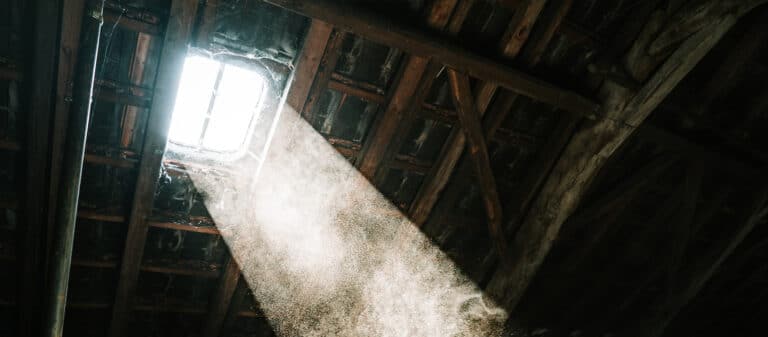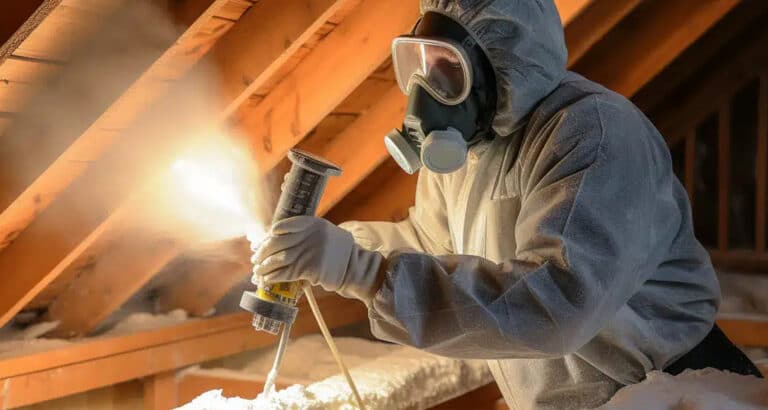Insulation is one of those modern amenities that many of us take for granted. From heat retention to acting as a natural allergy and sound barrier, adding insulation to your home offers several benefits, particularly in the frigid climate of Northeast Pennsylvania.
But is there a thing as too much or too little insulation? Does every part of my home require insulation, and if so, is the insulation the same amount?
These are questions we often receive from customers, and the simple answer comes down to one measurement: the R-value.
You may find this value listed on the packaging of your fiberglass batt or spray foam insulation, but understanding what it means and how much you need will help you achieve the best return on investment (ROI) on your insulation.
This guide will help you understand insulation R-value, how to calculate it, and how much insulation you’ll need to meet recommended R-values in Northeast Pennsylvania.
What Is R-value In Insulation?
R-value measures an insulation material’s heat resistance. Generally, the higher the R-value, the better the material will insulate a space and keep it warm during the winter.
Similarly, higher R-value insulation will also block out heat during the summer, keeping your home cool during peak temperatures in July and August.
When selecting insulation for a project, it is essential to consider the R-value. However, maximizing the insulation R-value is not always necessary, and in some cases, it can actually create problems in poorly ventilated homes.
Therefore, your contractor will recommend an appropriate R-value based on several factors, including the age of your home, the amount of existing insulation it has, and your budget.
How Is R-value Calculated?
Before selecting the right type of insulation for your home, it is essential to understand how the R-value of insulation is calculated. Insulation R-value is cumulative, meaning that adding additional layers of material on top of the base layer of insulation will increase the overall R-value.
All types of insulation have an approximate R-value per inch of thickness, which is used by manufacturers and consumers to determine the cumulative R-value based on the thickness or application of a project.
For example, when comparing different insulation materials, you can see which materials perform better than others.
| Insulation Material | Approximate R-value per Inch |
| Fiberglass Batts | R-2.9 to R-3.8 |
| Blown-In Cellulose | R-3.2 to R-3.8 |
| Spray Foam (Closed-Cell) | R-6.0 to R-7.0 |
| Spray Foam (Open-Cell) | R-3.5 to R-3.8 |
| Rigid Foam Board (Polyiso) | R-5.6 to R-8.0 |
As you can see, closed-cell spray foam and rigid foam board are the highest performing materials.
However, rigid foam board is not practical for many applications and is typically installed in a single layer with spray foam or fiberglass batts surrounding it.
In addition, most store-bought insulation materials are not packaged in one-inch rolls and are thicker, which is why you’ll often find fiberglass batts or rolls with R-values of 15, 30, 45, or higher.
Finally, only spray foam insulation provides complete air sealing of the surrounding area, meaning that, despite how high your fiberglass batts’ R-value may be, you still may suffer from drafts if you have an air leak in your attic.
Why R-value Matters in Northeast Pennsylvania
Nevertheless, R-value is an essential component of selecting the right type and amount of insulation for your project.
Northeastern Pennsylvania homes face unique weather challenges, from winters that bring constant freeze-thaw cycles to brutal summer months, which have been hotter than normal in recent years.
Some benefits of selecting a high-performance R-value insulation include:
- Preventing drafty rooms and improving overall temperature regulation
- Reducing heating bills, especially as energy costs rise
- Reducing strain on your HVAC system
- Preventing ice dams on roofs (attic insulation)
- Reducing allergies inside your home
- Providing natural sound proofing between rooms or levels of your home
Recommended R-values for NEPA’s Climate
As previously stated, maximizing insulation R-value for each area of your home is unnecessary in many instances.
Fortunately, the U.S. Department of Energy and EnergyStar have outlined a recommended set of R-values for homes in Climate Zone 5, which covers all of Northeast PA:
| Area of Home | Recommended R-value |
| Attic | R-49 to R-60 |
| Walls (above grade) | R-13 to R-21 |
| Floors | R-25 to R-30 |
| Basement walls | R-11 to R-19 |
Understanding this data, we can select the right type and amount of insulation for your project, saving you money and delivering the best performance.
Factors That Influence R-value Performance
The R-value is just one factor impacting the overall performance of your insulation, which is why we strongly caution against DIY installation.
1. Installation Quality
Even the highest-rated insulation won’t perform well if it’s poorly installed. Gaps, compression, and moisture damage can drastically reduce the effectiveness of insulation.
For example, a fiberglass batt rated R-19 might only perform like an R-11 if it’s squished between studs or installed around obstructions improperly.
Furthermore, precautions must be taken when installing around soffit vents, light fixtures, and attic doors to account for ventilation and prevent fire hazards. In worst-case scenarios, poor insulation installation not only impacts its performance but can also lead to mold, fires, or pest damage, which can compromise its longevity.
2. Moisture
As mentioned above, moisture and ventilation are significant concerns when installing insulation, particularly for older homes in the region. For one, any leaks in your roof or attic could expose insulation material to rain or snowmelt, causing the material to lose its effectiveness and even risk mold growth.
Similarly, installing insulation without proper ventilation can cause humidity to build up and lead to the same consequences.
3. Air Leaks
Insulation is only part of the equation. If your home has drafts or unsealed gaps, air can bypass even the best insulation, resulting in drafts and higher energy bills. Air sealing combined with insulation will deliver the highest comfort and energy savings.
How to Determine the Right R-value for Your Project
While higher R-values do improve thermal resistance, there’s a point of diminishing returns. In other words, adding more insulation beyond the recommended R-value won’t always translate to significant energy savings.
A professional insulation contractor can help assess whether your home is under-insulated or already optimized based on:
- Building age and design
- Existing insulation levels
- Local climate
- Energy audit results
In many older homes in Northeast PA, the attic is the most common weak spot, followed by uninsulated basement walls and drafty rim joists.
Understanding the insulation R-value is essential for making informed decisions about your home’s energy efficiency. Whether you’re planning to upgrade attic insulation or tackle a full-home retrofit, the right R-value ensures your home stays comfortable through Northeastern Pennsylvania’s bitter winters and humid summers.
If you’re unsure whether your insulation meets standards, consider consulting a trusted local insulation contractor, such as NEPA EnergySmart. A professional assessment can help you identify insulation gaps and suggest cost-effective solutions to improve your home’s efficiency, comfort, and resale value.
FAQs
What does R-value stand for?
R-value stands for “Resistance Value.” It measures how well insulation can resist heat flow. The higher the R-value, the more effectively the insulation slows down the transfer of heat.
Can insulation lose its R-value over time?
Yes. Factors such as moisture, settling, poor installation, and physical damage can reduce the effectiveness of insulation over time. Regular inspections and proper air sealing help maintain performance.
Is spray foam insulation better than fiberglass because of a higher R-value?
Spray foam typically has a higher R-value per inch, especially in the case of closed-cell foam. However, the “best” choice depends on your home’s specific needs, budget, and where the insulation will be installed. A professional can help you compare options.






